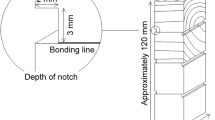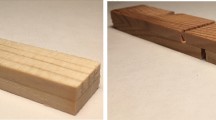Abstract
Eight urea-formaldehyde (UF) glues and one acid phenolic (PF) glue were compared with “established” glues of the casein and resorcinol (RF) types as for long-term durability, by use of accelerated and natural ageing. The purpose was to evaluate these glues for structural softwood bonding.
After unprotected outdoor exposure, only the phenolresorcinols (PRF) still meet the delamination requirements of the Norwegian Glulam Control (Norsk Treteknisk Institutt, 1975) after 10 years. In the case of indoor (30 years) and protected outdoor exposure (22 years), all glues except acid PF still have sufficient dry strength left when judged by Norwegian Standard 3470 (NSF 1979). The wet strength after 30 years (not tested for caseins) is still satisfactory for the RF/PRF adhesives and for the modified UFs, but not for the straight UFs and the acid PF. The accelerated ageing distinguished between glue types in the same order as natural ageing.
Conclusions: The caseins and the modified UFs are considered suitable for indoor and protected outdoor exposure. The RF and PRF adhesives are considered suitable for indoor as well as outdoor exposure. The acid PF is considered unsuitable, and the straight UFs with inert fillers should be regarded with suspicion due to their steadily decreasing wet strength.
This experiment was supported by The Royal Norweigian Council for Scientific and Industrial Research, and by Casco Nobel AB and Dyno Industrier A/S.
Zusammenfassung
Acht UF-Harze und ein säurehärtendes Phenolharz wurden mit konventionellen Kasein- und Resorcinharzen (RF und PRF) verglichen. Die Alterungsbeständigkeit wurde unter dem Einfluß von natürlicher und beschleunigter Alterung untersucht. Nach 10 Jahren im Freien wurden die Anforderungen der Norwegischen Leimholzüberwachung (NTI 1975) in bezug auf Delaminierung nur von den PRF-Klebern erfüllt. Nach Innenlagerung (30 Jahre) und geschützter Außenlagerung (22 Jahre) wiesen alle Kleber außer dem säurehärtenden PF-Harz noch befriedigende Trockenfestigkeiten auf, wenn sie nach dem norwegischen Standard NS 3470 (NSF 1979) geprüft wurden. Die Naßfestigkeit (die für Kaseinkleber nicht geprüft wurde) ist für die RF/PRF-Harze und die modifizierten UF-Kleber noch befriedigend; dies gilt allerdings nicht für die reinen UF-und PF-Kleber. Die beschleunigte Alterung im Wechselklima führte zur gleichen Rangfolge. Schlußfolgerung: Kasein- und modifizierte UF-Kleber können sowohl für die Innen- als auch für geschützte Außenverwendung als geeignet angesehen werden. RF- und PRF-Kleber sind für Innen- und für Außenverwendung geeignet. Der säurehärtende PF-Kleber war unter sämtlichen Bedingungen für tragende Holzbauteile ungeeignet. Reine UF-Harze mit Füllern sollten wegen ihrer ständig abnehmenden Naßfestigkeit mit Vorsich verwendet werden.
Similar content being viewed by others
References
Bergin, E. G. 1958: Durability of Urea-Formaldehyde and Casein Adhesives at Elevated Temperatures. Forest Prod. Lab. of Canada. Techn. Note no. 8, 1958
Clad, W. 1960: Evaluation of Urea Resin Adhesives. Holz Roh. u. Werkst. 18 (1960), 391–400.
Clad, W. 1965: Über die Fugenelastizität ausgehärteten Leimfugen bei Holzverleimungen. Holz Roh. u. Werkst. 23 (1965), 58
Egner, K. andKolb, H. 1966: Versuche über das Alterungsverhalten von Leimen für tragende Holzbauteile. Holz Roh. u. Werkst. 24 (1966), 439–442
Hedlund, B. 1990. Syraskadade fenollimmade och stålarmerade Träbalkar. (Acid damaged phenolic glued and steel reinforced wooden beams). SP-Rapport 1990:27. Swedish National Testing and Research Institute. Borås, Sweden
Norsk Treteknisk Institutt (NTI), 1975: Production manual for making laminated wood constructions
Norges Standardiseringsforbund (NSF), 1979: Norsk Standard 3470, Prosjektering av trekonstruksjoner. Beregning og dimensjonering (Wood Constructions)
Raknes, E. 1968: Norsk Skogindustri 22 (4), 1968, 119
Raknes, E. 1971: Norsk Skogindustri 25 (11), 1971, 325
Raknes, E. 1976. Norsk Skogindustri 30 (6), 1976, 168
Raknes, E. 1981: Norsk Skogindustri 35 (10), 1981, 260, 270
Raknes, E. 1983: I & EC Products Res. & Development 22, 1983, 662
Raknes, E. 1987: Norsk Skogindustri 41 (5), 1987
River, B. H.;Ebewele, R. O.;Myers, G. E. 1994: Failure mechanisms in wood joints bonded with urea-formaldehyde adhesives. Holz. Roh. u. Werkst. 52 (1994), 179–184.
Wangaard, F. F. 1946: Summary of information on the durability of water resistant woodworking glues. Report no. 1530, USDA, FPL, Madison, Wisconsin, USA
Author information
Authors and Affiliations
Rights and permissions
About this article
Cite this article
Raknes, E. Durability of structural wood adhesives after 30 years ageing. Holz als Roh-und Werkstoff 55, 83–90 (1997). https://doi.org/10.1007/BF02990523
Issue Date:
DOI: https://doi.org/10.1007/BF02990523




